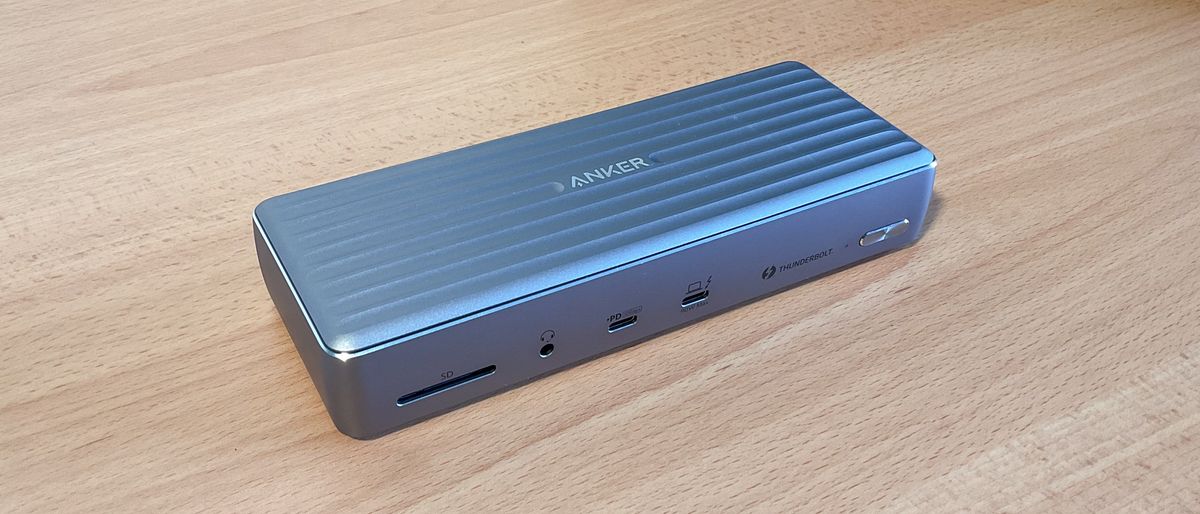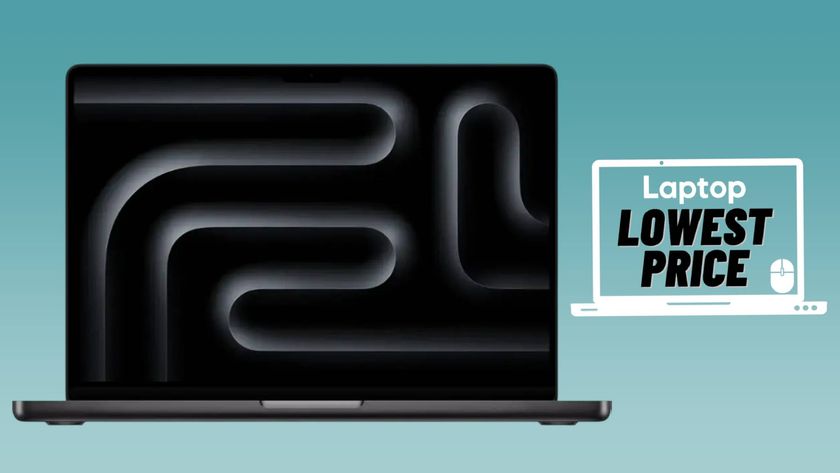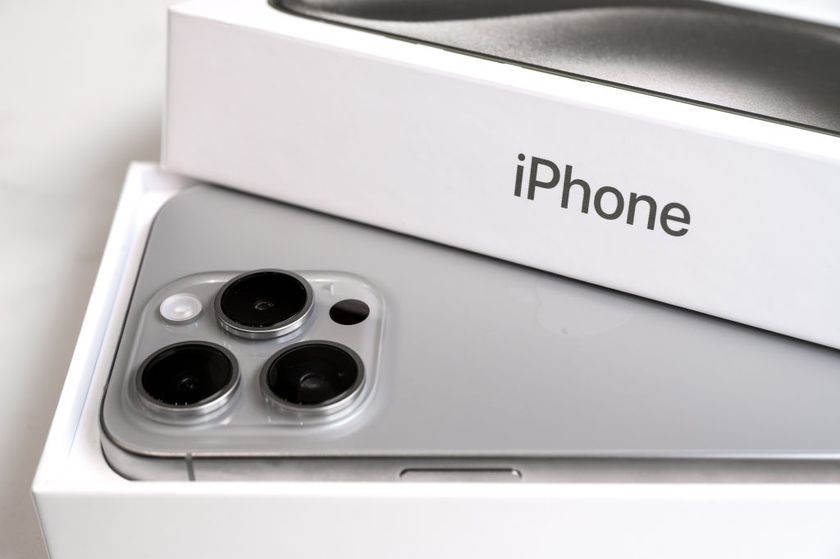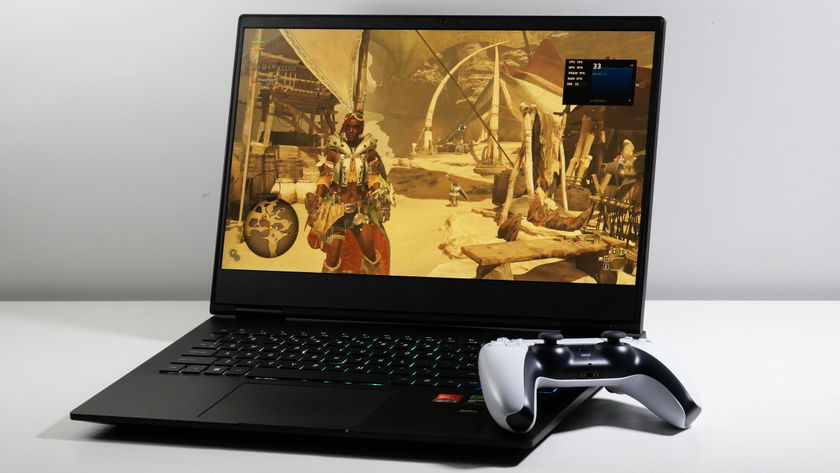Laptop Mag Verdict
The Anker Apex Thunderbolt 4 Docking Station is a premium 12-in-1 hub offering power and versatile connectivity in a distinct chassis, let down by compatibility.
Pros
- +
12-in-1 hub
- +
Thunderbolt 4 ports
- +
Single 8K 30Hz and dual 4K 60Hz
- +
90W power delivery
- +
Distinct design
Cons
- -
Expensive
- -
Limited compatibility
Why you can trust Laptop Mag
Price: $299.99
Ports: 2 x Thunderbolt 4, 1 x USB-C 3.1 Gen2, 2 x USB-A 3.1 Gen2, 2 x USB-A 2.0 Gen1, 2 x HDMI 2.0, 1 x UHS II SD 4.0 Card Reader, 3.5mm audio jack, Gigabit Ethernet Port
Supports: Windows 10 laptops with Thunderbolt 4 ports and non-M1 MacBook models running macOS Big Sur 11 (or later).
Anker has made a name for itself when it comes to charging technology, so it’s fitting the company dubbed its finest hub to date the Apex Thunderbolt 4 Docking Station. There’s a reputation to uphold when being a self-proclaimed “Apex” predator of the connectivity jungle, but Anker has taken steps to ensure its docking station stays unrivaled — 12 steps, to be precise.
Also known as the PowerExpand Elite 12-in-1 Thunderbolt 4 Dock, Anker’s docking station offers a list covered in checkmarks: next-generation Thunderbolt connectivity? Check. Multiple USB-A ports to slot in plenty of PC peripherals? Check. HDMI outputs delivering dual 4K resolution at a 60Hz refresh rate? Checks all round, and the list doesn’t stop there.
Anker’s 12-in-1 hub sets the bar high in terms of ports, but M1 MacBook users and those without a Thunderbolt 4 laptop will find that it's all for naught. A $300 price tag is a hefty chunk of change, especially for a docking station that isn’t fully compatible with several of the most popular laptops on the market. Is Anker’s “apex” device too ahead of the curve? Let’s find out.
Anker Apex Thunderbolt 4 Docking Station price and availability
The Anker Apex Thunderbolt 4 Docking Station is one of the priciest docking stations on the market, placed between Kensington’s $289.99 SD5700T Thunderbolt 4 docking station and Razer’s $329.99 Thunderbolt 4 Dock Chroma. To put that into perspective, you could purchase an Oculus Quest 2 virtual reality headset for the same price.
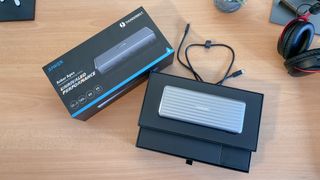
Keep in mind, however, that this 12-in-1 dock is meant to last. With the inclusion of two Thunderbolt 4 ports, Intel's next generation of universal cable connectivity, Anker is future-proofing its docking station to keep up with modern laptops such as the Dell XPS 13 9310, Asus ROG Zephyrus M16, HP ZBook Firefly 14 G8, and many more.
Including other USB-A and USB-C ports means it's compatible with the vast majority of PC accessories, from keyboards to USB sticks, too. Plus, while they bring out its full potential, Thunderbolt 4 ports are backward compatible with Thunderbolt 3, USB Type-C and USB 4.0 accessories.
Anker Apex Thunderbolt 4 Docking Station design
If you’re like me and have been contemplating why the Anker Apex Thunderbolt 4 Docking Station looks so familiar, I cracked the, erm, case. The dock has an uncanny resemblance to a RIMOWA Original suitcase.
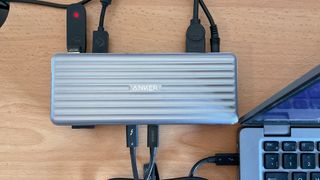
Like the iconic luggage brand’s classic suitcase collection, Anker’s hub has distinct aluminium grooves covering its top and bottom side, with Anker’s signature logo placed in the middle. It looks premium, and will fit right in with any high-end work setup. Like the suitcase, the dock is quite thick, but this gives it plenty of room to neatly store various well-spaced ports.
I appreciate when a manufacturer lays out its ports to prioritize convenience, and Anker nails it in this regard. The front side of the dock offers easy access to some of the more popular ports, including SD cards, wired headphones and USB-C cables to charge smartphones. The Thunderbolt 4 port primarily used to connect a laptop is also found here. On the rear, you’ll find slots for more permanent PC peripherals and connections that aren’t usually moved around, such as HDMI outputs and USB-A ports for a mouse and keyboard. This cleans up the mess of cables for those who need to always keep tidy.
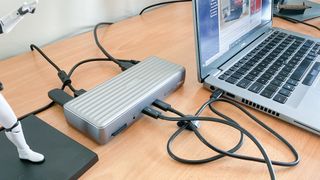
Coming in at 1 pound (0.46kg) with dimensions of 7.3 x 2.9 x 1.3 inches (186 x 74 x 33 millimeters), the Apex docking station is a device meant to take up a permanent spot on your work setup. It's slightly bigger and heavier than the Kensington SD5700T docking station (0.9 pounds, 7.1 x 3 x 1.2 inches).
A dock stand is sold separately so Anker’s docking station can stand upright, which is disappointing considering the costly price. That said, its horizontal setup won’t take up much real estate on your desk. Plus, if you do need to travel with it, it has a sturdy chassis and streamlined design so it can easily be slipped into a laptop bag. Or, since it looks like one, a suitcase.
Anker Apex Thunderbolt 4 Docking Station ports and connectivity
While the Anker Apex Thunderbolt 4 Docking Station shines by having the next generation of high-speed connectivity, it’s made even better thanks to its multitude of ports.
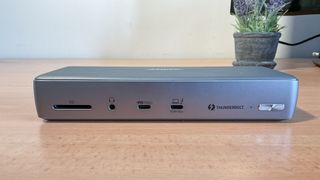
On that front, there’s a power button, a UHS II SD 4.0 card reader, a convenient 3.5mm audio jack for those with wired headphones, a USB-C 3.1 Gen 2 port that offers 10Gbps transfer speeds and acts as a 9V / 2.25A charging port for smartphones, and a wicked Thunderbolt 4 upstream port with up to 40Gbps transfer speeds and an impressive 90W for charging. That means I didn’t need to use another power outlet to charge my laptop — all you need is one connection.
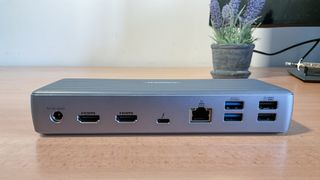
Along the rear, there are two USB-A 2.0 ports offering 480Mbps speeds and 5V/0.5A power (mainly used for keyboards, a mouse or other peripherals), two USB-A 3.1 ports with 10Gbps transfer speeds and 5V/0.9A for charging, one Gigabit Ethernet port, along with a Thunderbolt 4 downstream port offering 40Gbps speeds, 15W power and up to 8K display resolution at 30Hz (or 4K at 60Hz) when connected to a monitor. There’s also two HDMI 2.0 outputs offering 4K resolution at 60Hz for good measure.
Thanks to the USB-C physical connector, the docking station pairs great with the best USB-C monitors. Thunderbolt 4 sends a video signal to two 4K displays, or to one 8K display, so if you have the money, it might be time for a monitor upgrade.
Anker Apex Thunderbolt 4 Docking Station performance
While being named the Anker Apex Thunderbolt 4 Docking Station suggests the dock is unrivaled in the field (if the marketing slogan on its packaging was any more of an indication), I wouldn’t say it's unmatched. But it is certainly hard to beat.
Nearly every port can be used to charge a device, with the dock being powered by a 120W power adapter. The port that takes the cake is the front Thunderbolt 4 port offering 90W power, which could easily transfer, charge and connect all my PC accessories with just one cable plugged into my Dell Latitude laptop. I decided to give it more of a challenge by seeing if it could charge the demanding Asus ROG Strix G17 (G733QSA-XS99).

The 12-in-1 hub powered the laptop without a sweat, all while I had my Logitech G Pro K/DA keyboard, HyperX Cloud II Wireless headphones via USB-A stick, and Razer Naga Pro mouse plugged in while scavenging the nuclear wasteland in Metro Exodus. My smartphone was charging via the 20W USB-C port at fast speeds, too.
Anker also states the hub can transfer a 20GB file in 14 seconds when you use the Thunderbolt 4 port, or in just 26 seconds when you use the USB-C port. Sure enough, I transferred a similarly sized file (Disco Elysium: The Final Cut at 18GB) in no time using the USB-C port.
What’s more, having an SD card reader is a fantastic addition for professionals when transferring data or storing photos, especially if their laptop doesn't come with one.
While my work setup isn’t typically too demanding, I did find a couple of hiccups. Because the Asus ROG Scar 17 doesn’t have a Thunderbolt 3 port, it couldn’t extend to another monitor over the Thunderbolt 4 port. However, the Dell Latitude supports Thunderbolt 3, and I used a second monitor with just one connection. Here lies a shortcoming of Anker’s Apex Thunderbolt 4 docking station — it has limited compatibility for laptops that don’t support Thunderbolt 4.
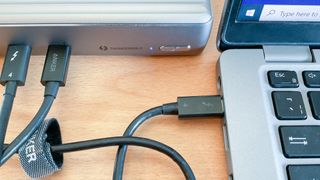
Without a Thunderbolt 4 laptop, Anker’s dock can’t be used to its full potential. This means the 40Gbps transfer speeds and 8K at 30Hz potential is wasted. At the same time, there aren’t many people who will have an 8K monitor to link up to right now. I’m happy to see Anker include two HDMI 2.0 outputs to make up for this, and they both work without a hitch.
The Anker Thunderbolt 4 Docking Station isn’t compatible with M1 MacBook models. Seeing as the future of Apple’s popular laptops is its Silicon chip, this docking station may not be the best option for those who own an M1 MacBook.
Bottom line
So, is the Anker Apex Thunderbolt 4 Docking Station too ahead of the curve? Yes, but it’s also a versatile hub that can improve your current work setup while helping you prepare for the next generation of laptops set to become the norm. Its Thunderbolt 4 ports are convenient and speedy, while the 12-in-1 hub’s other ports allow you to charge and connect plenty of PC accessories and monitors.
Anker’s dock is let down by an expensive $300 price point for a device that can’t be fully utilized without a Thunderbolt 4-supported laptop. However, give this suitcase imposter some time and it’s sure to shine. If Thunderbolt 4 connectivity is too far ahead in the future for your kit, check out more of the best docking stations on the market today.

Darragh Murphy is fascinated by all things bizarre, which usually leads to assorted coverage varying from washing machines designed for AirPods to the mischievous world of cyberattacks. Whether it's connecting Scar from The Lion King to two-factor authentication or turning his love for gadgets into a fabricated rap battle from 8 Mile, he believes there’s always a quirky spin to be made. With a Master’s degree in Magazine Journalism from The University of Sheffield, along with short stints at Kerrang! and Exposed Magazine, Darragh started his career writing about the tech industry at Time Out Dubai and ShortList Dubai, covering everything from the latest iPhone models and Huawei laptops to massive Esports events in the Middle East. Now, he can be found proudly diving into gaming, gadgets, and letting readers know the joys of docking stations for Laptop Mag.
